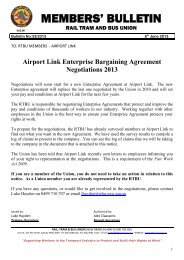Safety Matters - Rail, Tram and Bus Union of NSW
Safety Matters - Rail, Tram and Bus Union of NSW
Safety Matters - Rail, Tram and Bus Union of NSW
Create successful ePaper yourself
Turn your PDF publications into a flip-book with our unique Google optimized e-Paper software.
3. Specify objectives or performance measures<br />
OHS programs should specify objectives in order to determine their success.<br />
Objectives should be specific, measurable <strong>and</strong> achievable. They should also<br />
make reference to time, cost <strong>and</strong> quality requirements where applicable.<br />
4. Monitor the program<br />
Programs should be reviewed at the end <strong>of</strong> the stated time frame, however it<br />
is usually necessary to monitor the program on an ongoing basis to enable<br />
problems to be dealt with as they arise, or modifications to be made if required.<br />
For example, additional resources may need to be allocated, a certain type <strong>of</strong><br />
training may be required, new information or legislation may affect current<br />
actions etc.<br />
Mechanisms should be established to enable employees <strong>and</strong> supervisors to<br />
express their concerns about any aspect <strong>of</strong> the program. The OHS committee<br />
<strong>and</strong>/or OHS representative should be involved in this process to strengthen<br />
consultation <strong>and</strong> commitment.<br />
5. Evaluate <strong>and</strong> review<br />
Programs must be flexible. Once in place they must be reviewed to ensure<br />
their objectives are being met in effectively promoting health <strong>and</strong> safety in<br />
the workplace. The OHS committee/OHS representative should have a role in<br />
the process <strong>of</strong> review <strong>and</strong> evaluation. They can then make recommendations<br />
to management about what should be done in the future to enable continual<br />
improvement or take corrective action. This should be done with direct reference<br />
to the stated program objectives or performance measures.<br />
One method <strong>of</strong> evaluating the program could be for the OHS committee/OHS<br />
representative to survey employees <strong>and</strong> supervisors about the effectiveness <strong>of</strong><br />
the program at the end <strong>of</strong> a designated period.<br />
If the program is successful <strong>and</strong> a decision is made to continue with it on a<br />
permanent basis, periodic review is important. Changes in technology, legislation<br />
<strong>and</strong> work systems may result in improved prevention <strong>and</strong> control strategies.<br />
<strong>Safety</strong> <strong>Matters</strong> A Guide for Workplace OHS Representatives<br />
SECTION TWO<br />
RAIL<br />
TRAM AND BUS<br />
19<br />
Monitoring OHS Programs <strong>and</strong> Procedures<br />
U N<br />
I O N

















